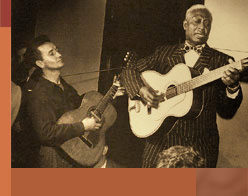|
Sound Clips
 Audio -
Guitarist and vocalist Doug Wamble uses the example of his grandfather to
show that "country" means more than just a style of music.
Audio -
Guitarist and vocalist Doug Wamble uses the example of his grandfather to
show that "country" means more than just a style of music.
 Audio - Doug
Wamble talks about an increased willingness to acknowledge white appropriation
of black musical innovations -- he argues that Elvis Presley employed black
styles out of admiration rather than purely commercial motives.
Audio - Doug
Wamble talks about an increased willingness to acknowledge white appropriation
of black musical innovations -- he argues that Elvis Presley employed black
styles out of admiration rather than purely commercial motives.
 Audio -
Saxophonist Andrew Love and trumpeter Wayne Jackson, who together make up
The Memphis Horns, say that musicans are less prone to racial prejudice than
other groups of Americans, since what really matters in a band is whether
a person can play.
Audio -
Saxophonist Andrew Love and trumpeter Wayne Jackson, who together make up
The Memphis Horns, say that musicans are less prone to racial prejudice than
other groups of Americans, since what really matters in a band is whether
a person can play.
 Audio -
Multi-instrumentalist Clarence "Gatemouth" Brown argues that white musicians,
particularly from the U.K., have been able to become superstars by copying
black styles, without inventing anything new.
Audio -
Multi-instrumentalist Clarence "Gatemouth" Brown argues that white musicians,
particularly from the U.K., have been able to become superstars by copying
black styles, without inventing anything new.
 Audio -
Clarence "Gatemouth" Brown says his prediction about rap -- that whites would
start imitating it almost immediately -- has come true.
Audio -
Clarence "Gatemouth" Brown says his prediction about rap -- that whites would
start imitating it almost immediately -- has come true.
 Listen
to Part 11 Listen
to Part 11
“Whites and blacks…” writes
Francis Davis in The History of the Blues, “…living in
close proximity in cramped little Southern towns…were able to keep
few secrets from each other [despite social dictates intended to
keep them separate]. They smelled each other’s food and heard each
other’s music…. Rock ‘n’ roll is supposed to have come screaming
and kicking to life as the love child of blues and country &
western in the early 1950’s. But blues and country may themselves
have been among the fruit of an earlier back-of-town rendezvous,
between the field holler and the rhymed, Scots-Irish narrative ballad.”
Despite the segregation in American life and law, music didn’t follow
lines put down by society. The evidence, as seen in both commercial
and ‘field’ recordings, is rather that black and white musicians
fed off of each other musically, and through this exchange created
an American music; a common culture. We hear this continuing fusion
and synthesis today in blues, bluegrass, country, pop, rap, and
urban music.
Humanities Themes:
With the rich musical interchange between black and white, folk
art became America’s unique musical tradition.
In fact, the lines between audience and artist blurred because of
the everyday subject matter that many songs touched upon. Because
of the participatory nature of performances, an audience member
could easily cross the threshold and become a performer.
Black African / African American
and White European music and the influence they had upon each other.Black styles on Italian
Cremona violins dating from 18th C.
Music in a segregated society.
We look at common cultural
elements that were exchanged and shared in social situations (like
dances and other public gatherings) between black and white communities
and musicians. A new American musical mainstream was created that
both drew from and eroded local and regional black and white culture.
We explore the subject of segregation
in the early recording industry and how it affected the exchange
of information between blacks and whites. Also, as commercial interests
began to influence the recording industry, we’ll explore how the
industry’s segregation practices changed. Some key musicians circumvented
segregation in the music industry, although some racial divisions
(musical and social) remain in effect even to this day.
Music has long had an important
role in social change. Social occasions that brought white audiences
to hear black performers and occasionally to make music with them.
Homegrown folks who played together thumbed their nose at Jim Crow
laws. From at least the thirties, social protest movements brought musicians
of different backgrounds together for a common cause. They established
a common repertoire and shared elements from their own traditions.
Storylines:
The music of America is a distinct
creation, based largely on a synthesis of African American and white
European music and musical traditions.
Primary Storyline -- The pivotal
character in our story is Lesley Riddle, who influenced the Carter
Family: We’ll investigate the following questions: How did Riddle
bring black music to the white Carter Family? What white influences
did Riddle carry even before influencing the Carters, such as Scotch-Irish
narrative ballads? How did the mixing of music in this instance
mirror what was going on in American society at the time? We’ll
explore the story of “Cannonball Blues,” a song Lesley Riddle taught
to A.P. Carter around 1927.
Secondary Storylines – The
secondary story line will revolve around black and white musicians’
interactions despite social conventions, dictates, and restrictions that
were enforced successfully in the South outside of music. From plantation
days, when black musicians entertained white audiences with their
versions of white fiddle tunes along with their own repertoire (ex.
Gribble, Lusk & York) there has always been a mixing of musical
worlds.
In the remarkably fertile musical
soil surrounding Galax, VA, fiddler Tommy Jarrell learned “Raleigh
& Spencer” from black guitarist and singer Jim Raleigh. Hobart
Smith adopted a blues guitar style and sang both black blues and
white country songs. Fields Ward picked up style and repertoire
(including “Chilly Winds and “Lonesome Road Blues) from black hobos
around the Galax rail yards.
|

